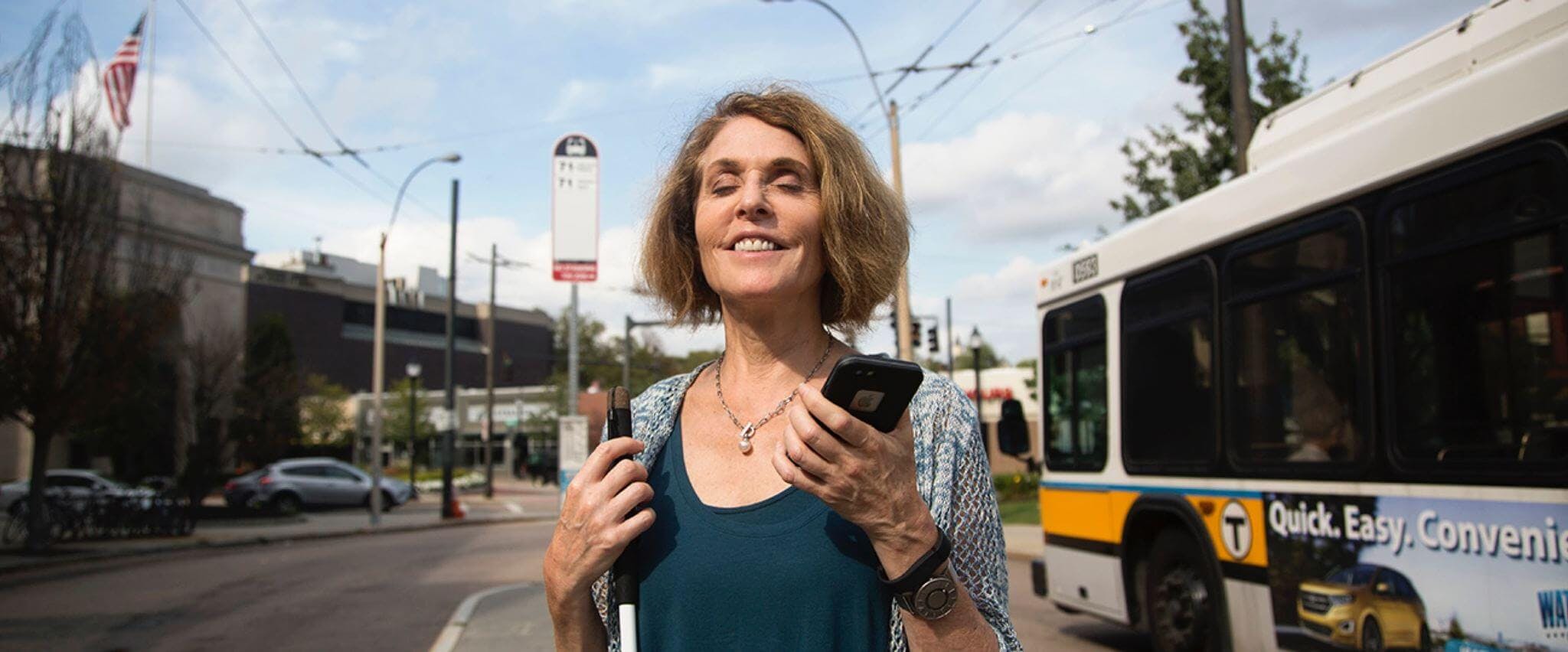

Massachusetts Bay Transportation Authority
Rightpoint partnered with the Massachusetts Bay Transportation Authority (MBTA) and Perkins School for the Blind to use beacon technology at bus stops. The Blindways app helps visually impaired commuters get closer to the bus stop. This MBTA app helps visually impaired commuters experience a far easier commute when utilizing the crowdsourcing cues. While this technology was helpful, there was still room for improvement. With feedback and field testing, developers set out to improve the beacon technology used by the MBTA iPhone app.
Our work with Perkins School for the Blind demonstrated how difficult it is for a visually impaired person to take public transportation with confidence.
While GPS data points may put someone close to the bus stop when using the MBTA app, the user can still end up quite far away. This causes the bus driver not to take notice and the commuter to miss their ride altogether. The BlindWays app was built to use crowdsourcing techniques to help visually impaired riders find bus stops easily. Riders rely on crowdsourced clues rather than GPS data to get a more accurate sense of where the bus stop is. MBTA and Rightpoint wanted to explore if beacon technology could serve as an additional input to help riders with any micro-navigation challenges.

The project required many internal trials, followed by real-time usability tests.
Going into this project Rightpoint knew that GPS distance notifications were less reliable than beacons for two key reasons:
GPS doesn’t always have the correct stop location, which means its estimated distance to the stop is also inaccurate. Beacons don’t have this problem since they are directly mounted to the stop sign.
Buildings and trees can block GPS signals or cause reflections, resulting in incorrect positioning of users’ location and jitter. Although beacons also face this problem, they still are more accurate in determining users’ proximity to the stop than GPS. More so, their level of accuracy becomes greater as users get closer to the stop.
The project kickoff included experimenting with different beacon placements on the bus stop. Having beacons on each side of the stop sign pole, parallel to the street, proved to be the most optimal placement. This allowed for better beacon detection as users approached the stop from either direction of the sidewalk. Updates were made to the BlindWays app so it switched over from GPS distance estimates to beacon distance estimates when the users’ iPhone detected beacon signals. The app triggered the following VoiceOver announcements as users approached the stop:
“You’re within 100 feet of the stop” (when users were in a zone with weak beacon signals)
“You’re within 30 feet of the stop” (when users were in a zone with medium beacon signals)
“You’re within 10 feet of the stop” (when users were in a zone with strong beacon signals)
Using iPhone’s Taptic Engine, the app triggered a vibrating sensation which changed from slow, medium, and fast as users moved closer to or away from the stop. Rightpoint performed several field tests with blind/vision impaired users in order to evaluate the success of the work, and inform further enhancements. The results of testing showed that beacon distance notifications jumped back and forth inconsistently as users moved closer to the bus stop.
During one test, the notification switched back and forth from 30 feet to 100 feet although the user was continuously navigating toward the stop. This may have resulted from the fact that beacon signal strengths can vary widely due to blocked or bouncing signals. Trying to determine specific distances based on beacon signal strength proved to be a poor strategy.
To mitigate this issue, we:
Delayed the switch from GPS distance notifications to beacon distance notifications until we received stronger beacon signals. This was done in order to prevent the app from switching back and forth from GPS to beacons when beacon signals were lost.
Removed the distances stated in the VoiceOver announcements, and reduced the number of announcements. Users would now hear only the following two announcements
Combined the beacon signals received into two segments, and relied more on iPhone’s Taptic Engine to communicate to users whether they were moving close to or away from the stop. The app triggered slower vibration while users were in a zone with weak and medium strength signals, and fast vibration while they were in a zone with strong signals.

The overall experience users had with the updated BlindWays app was far better than what was witnessed during the first field test.
The VoiceOver notifications and haptic feedback were triggered more accurately, and this resulted in users being able to locate their stop with ease and confidence. While only a few bus lines within Boston currently have support for beacons, the BlindWays app is available at over 8,000 bus stops in the Greater Boston Area. Rightpoint plans to test in different environments taking other factors into account, such as urban and suburban areas, with heavier and lower amounts of traffic (car and foot), the presence of many trees or buildings, and more.
Riders identified possible enhancements such as adding a push notification to encourage them to switch from GPS to the BlindWays app or to remind them to turn on their Bluetooth. Rightpoint plans to continue testing the accuracy of the Bluetooth beacon technology.
Mobile and Emerging Technology
Android
iOS
